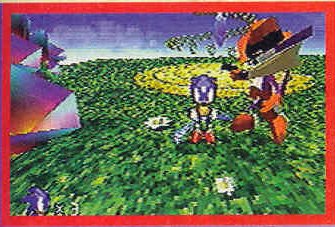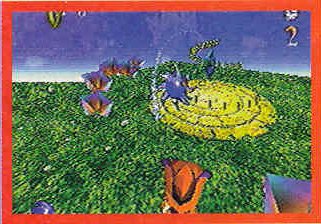|
This
article about Sonic X-Treme was written by Jared Matte, aka The
Green Gibbon! from The Green Hill Zone website. The GHZ decided
not to include Sonic X-Treme in it's vast data selection since
it was not released, and in turn gave their page to the SOST for
the world to read.
|
--
Sonic X-Treme --
In
May of 1996, Sega of America proudly announced the development
of the Saturn's killer app. The true Sonic game the doomed console
needed from the get-go. Moreover, it was set to go head-to-head
with Super Mario 64, the phenomenal return of Sonic's
chief rival. So what went wrong? Make yourselves comfortable,
children, and I'll tell you a little story...
--
Story --
Professor
Gazebo Boobowski and his daughter, Tiara, are the keepers of the
six magical Rings of Order, as well as the ancient art of Ring
smithing. Gazebo and Tiara freak that Dr. Robotnik is after the
six Rings of Order, and call on Sonic to get the Rings before
the Eggman can. Robotnik has already made one previous attempt
at stealing the Rings, and Sonic is the only one who can knock
the thought out of his head.
--
Behind the Screens --
The
earliest threads of the legend date back to 1994, almost immediately
following the completion of Sonic & Knuckles. At that time, Sega
of Japan and Sega of America were essentially two separate companies.
Sega of America wanted to do its own thing, but Sega of Japan
always had the final say, so there was alot of friction between
the two. The bigwigs over in the land of the rising sun were busy
putting together the destined-to-be underdog of the 32-bit war,
Saturn, but Sega's US division had plans of its own.
Sega
Technical Institute, SoA's software division, was already throwing
around ideas for the next major Sonic game. The title was originally
intended for the ill-fated 32X, but was quickly shifted to a
cartridge-based platform in development at SoA. This new console
was intended to rival Nintendo's N64, and the new Sonic game
was supposed to make it for launch. Sensing the inevitable conflict
between this cartridge system and their own CD-based Saturn,
Sega of Japan killed the cart muncher leaving the Sonic-to-be
with only one option.
We're
now into early 1996. Bernie Stolar, to whom the PlayStation's
success is often attributed, had just moved his digs from Sony
to Sega of America. With Nintendo's 64 launch looming on the
horizon, the Saturn was going to need a big gun for the holiday
season and Bernie was aware of this fact. Love him or hate him,
but Stolar is a man who knows his business, and he immediately
began shaking things up at Sega Technical Institute. Roger Hector,
head of STI, was ordered to compile a core team for Sonic X-Treme.
The chosen few were to be subjected to a high-pressure development
crunch with no freedom until the game itself was complete. The
"lucky" winners:
- Mike
Wallis - Producer
- Chris
Senn - Art director, co-lead designer, team coordinator, and
conceptual music
- Ofer
Alon - Technical director/engineer, lead programmer, and co-lead
designer
- Fei
Cheng - Computer graphics artist/designer and conceptual design
- Chris
Coffin - Lead boss stage/boss FX programming and conceptual
gameplay design
- Howard
Drossin - Music and sound effects director
- Ross
Harris - Lead computer graphics artist/animator and conceptual
design
- Jason
Kuo - Boss layout lead
- Andrew
Probert - Computer graphics artist/designer and conceptual
design
- Richard
Wheeler - Designer, world layout lead and conceptual gameplay
design
The
team was practically locked-up in STI headquarters. Meals
were brought in and the group essentially lived in the office,
working 15-16 hour days in their mad rush to get Sonic X-Treme
off the drawing board and onto store shelves in time for
Christmas. Despite the pressure, things started off well...
the team was enthusiastic and Stolar was generous in making
sure they had all the resources they needed. So where did
this plan begin going awry?
Over
in Japan, Sonic Team were busy working on their own Saturn
masterpiece, NiGHTS. The engine utilized in the game would've
made the ideal building block for a 3D Sonic title... such
as Sonic X-Treme. STI requested the NiGHTS engine, as creating
their own from scratch would've been too time-consuming
for their unreasonable deadline. Stolar happily obliged.
STI began familiarizing themselves with the engine, but
their luck ran out just two weeks later. Yuji Naka, it seems,
got wind of STI's acquisition of the NiGHTS technology.
This was during an era of intense rivalry between Sega Japan
and Sega US, and Naka hated Sega US. So, being the good
sport that he is, he went to the head of SoJ and demanded
that the NiGHTS engine be taken away from STI, threatening
to quit if his "request" wasn't carried out. What Yuji wants,
Yuji gets, so the NiGHTS engine was retracted leaving STI
to start from scratch. Things only got worse from there.
Ofer
Alon managed to get his own set of development tools up
and running on PC. The intent was to port the finished product
to the Saturn, but technical problems hindered the transition.
Alon's primary game engine featured 2D sprites running around
3D polygonal stages. A fish-eye camera system designed to
give players a full view to the left and right as well as
in and out was implemented. Much like the Special Stages
in Chaotix, all of X-Treme's worlds were built inside giant
"tubes" with no center of gravity, allowing the player to
run up walls. There were four planned Zones: Jade Gully,
Crystal Frost, Red Sands, and Galaxy Fortress.
Another
big gimmick for X-Treme was Sonic's vastly expanded roster
of moves. Aside from the standard spin, here's a list of
some cool-sounding tricks that, as fate would have it, never
made it into Sonic's collective arsenal:
- SpinBash
- A quick forward attack modified from the Spin Dash
- SpinSlash
- A mid-air, 360° attack
- Ring
Throwing - Sacrifice a Ring from the tally to hurl at an enemy
- Power
Ball - An attack designed to strike straight down on enemies
below
- Super
Bounce - A jump which offers more height, but less control
than a normal jump
- Ring
Shield - A way to forfeit collected Rings for a shield
- Sonic
Boom - A 360° attack used in conjunction with the Ring Shield
Chris
Coffin, working independently of Ofer Alon, created his
own boss engine based on the NiGHTS technology. Boss battles
were to be fought in large circular arenas. While Coffin
only managed to get two full-fledged bosses up and running
(series villains Fang the Sniper and Metal Sonic), they
were completely developed right down to the AI.


Despite
the circumstances, development continued and Sonic X-Treme
was beginning to take shape. Unbeknownst to the team, the
final blow was yet to come. During the summer of '96, right
in the thick of X-Treme's development, the head of SoJ caught
a glimpse of an early build. He favored Chris Coffin's boss
engine over Ofer Alon's game engine, and instructed the
team to scrap the latter entirely and build the whole game
on the boss technology. Alon quit the team and left Sega
in frustration, leaving the remaining crew with even more
to do in even less time. At this point, the entire project
was hinging on director Chris Senn, who was putting in 200%,
doing his best to pick up the slack. But after 7-8 weeks
of sleepless nights, even the energetic Senn reached his
limit. Producer Mike Wallis had no choice but to put the
hedgehog out of his misery. He broke the news to Stolar,
who officially ended the Sonic X-Treme project in favor
of their backup plan, Sonic 3D: Flickies' Island. Sonic
X-Treme was officially canned.
Even
after the death of the Saturn version, Chris Senn and Ofer
Alon continued work on a PC version of X-Treme. The PC build
came much farther along, with several complete levels playable.
The duo pitched the game to Sega's PC division, but the
suits there were content to simply do ports, and refused
to fund the project. This was the last of a series of dead-ends
for X-Treme.
Although
the game itself will never come to fruition as originally
planned, X-Treme lives on in the collective mind of fandom.
It's a popular source of rumor and intrigue.
|
|